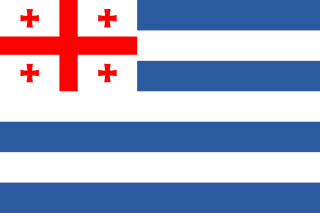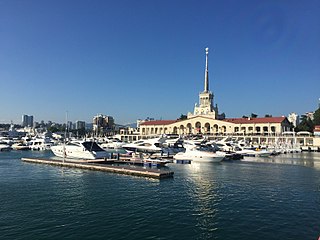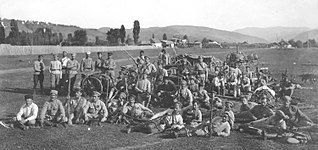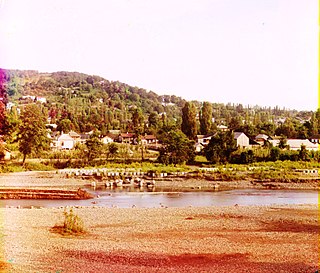
Georgia is a country in the Caucasus region, on the coast of the Black Sea. Sometimes considered a transcontinental country, it is located at the intersection of Eastern Europe and West Asia, and is today generally regarded as part of Europe. It is bordered to the north and northeast by Russia, to the south by Turkey and Armenia, and to the southeast by Azerbaijan.

Batumi, historically Batum or Batoum, is the second-largest city of Georgia and the capital of the Autonomous Republic of Adjara, located on the coast of the Black Sea in Georgia's southwest, 20 kilometers north of the border with Turkey. It is situated in a subtropical zone at the foot of the Caucasus. Much of Batumi's economy revolves around tourism and gambling, but the city is also an important seaport and includes industries like shipbuilding, food processing and light manufacturing. Since 2010, Batumi has been transformed by the construction of modern high-rise buildings, as well as the restoration of classical 19th-century edifices lining its historic Old Town.

Adjara or Achara, officially known as the Autonomous Republic of Adjara, is a political-administrative region of Georgia. It is in the country's southwestern corner, on the coast of the Black Sea, near the foot of the Lesser Caucasus Mountains, north of Turkey. It is an important tourist destination and includes Georgia's second most populous city of Batumi as its capital. About 350,000 people live on its 2,880 km2 (1,110 sq mi).

Sochi is the largest resort city in Russia. The city is situated on the Sochi River, along the Black Sea in Southern Russia, with a population of 466,078 residents, and up to 600,000 residents in the urban area. The city covers an area of 176.77 square kilometers (68.25 sq mi), while the Greater Sochi Area covers over 3,502 square kilometers (1,352 sq mi). Sochi stretches across 145 kilometers (90 mi), and is the longest city in Europe, the fifth-largest city in the Southern Federal District, the second-largest city in Krasnodar Krai, and the sixth-largest city on the Black Sea.

Krasnodar Krai is a federal subject of Russia, located in the North Caucasus region in Southern Russia and administratively a part of the Southern Federal District. Its administrative center is the city of Krasnodar. The third most populous federal subject, the krai had a population of 5,838,273 as of the 2021 Census.

Gagra is a town in Abkhazia/Georgia, sprawling for 5 km on the northeast coast of the Black Sea, at the foot of the Caucasus Mountains. Its subtropical climate made Gagra a popular health resort in Imperial Russian and Soviet times.

The Sochi conflict was a three-party armed conflict which involved the counterrevolutionary White Russian forces, Bolshevik Red Army and the Democratic Republic of Georgia, each of which sought control over the strategic Black Sea town of Sochi. The conflict was fought as a part of the Russian Civil War and lasted with varying success from June 1918 to May 1919, and ended through British mediation.

The peoples of the Caucasus, or Caucasians, are a diverse group comprising more than 50 ethnic groups throughout the Caucasus.

Abkhazia is a region in South Caucasus. It is a de facto independent republic, but internationally is mostly recognized as part of Georgia.

The Russian route A147 is a Russian federal highway, a mountain highway that runs along the coast of the Black Sea in Krasnodar Krai from Novorossiysk through Gelendzhik, Tuapse, and Greater Sochi to Adler. The road terminates at Russia's border with Abkhazia/Georgia.

Anaklia is a town and seaside resort in western Georgia. It is located in the Samegrelo-Zemo Svaneti region, at the place where the Enguri River flows into the Black Sea, near the border with Abkhazia.

Batumi is the capital city of Adjara, an autonomous republic in southwest Georgia, located on the eastern coast of the Black Sea.

Khelvachauri is a municipality in Georgia's southwestern autonomous republic of Adjara with a population of 52,737 people (2021). The administrative center is the town of Khelvachauri, which is located for the most part within the Batumi municipal boundaries since 2012. The municipality covers an area of 356.4 km2 (138 sq mi) and has 64 villages spread over 11 administrative units in the relatively densely populated hills around the city of Batumi.

European route E 97 is an A-class European Route in Ukraine, Russia, Georgia, and Turkey. The highway runs for 1,360 kilometres (850 mi) in total. It connects the North Black Sea region with the South Black Sea region along the eastern shores of the sea.

The area of the Russian city of Sochi was populated more than 100,000 years by ancient people of Asia Minor migrating through Colchis. Ancient Greeks sailed to the region via the Black Sea in the 5th–6th centuries BC and encountered the Maeotae, Sindi, Cercetae, Zygii and other local tribes. They were the ancestors of the Abkhaz, Ubykh and Adyghe people who lived here until 1864; many toponyms in Sochi, including the city itself, originate from their languages. The first Russian outpost was set up in central Sochi in 1838 as a part of the Russian expansion along the Black Sea coast. The local resistance to this process became a part of the Russo-Circassian War which ended in a Russian victory and the genocide of the local population. The Russian settlement built in the area was named Sochi in 1896 and received the status of a city (town) in 1917. The first tea plantations were established there in 1901–1905 and resulted in the production of the most prominent brand of Russian tea. From the end of the 19th century, the city has been developed as a dedicated area for sanatoriums and hospitals. It served as a rehabilitation center during World War II and, despite a decline following the dissolution of the Soviet Union, remains the major resort town of Russia. An important recent event was selection of Sochi as the site of the 2014 Winter Olympics and 2014 Winter Paralympics.

Khostinsky City District is one of four city districts of the city of Sochi in Krasnodar Krai, Russia. The city district borders Maykopsky District of the Republic of Adygea in the northeast, Adlersky City District in the southeast, Tsentralny City District in the west, and Lazarevsky City District in the northwest. In the southwest, it is bordered by the Black Sea. Population: 65,229 (2010 Russian census); 62,515 (2002 Census); 65,713 (1989 Soviet census).
Lazarevsky City District is one of four city districts of the city of Sochi in Krasnodar Krai, Russia. The city district borders Tuapsinsky District in the northwest, Apsheronsky District in the north, Maykopsky District of the Republic of Adygea in the northeast, Khostinsky City District in the east, and Tsentralny City District in the south. The administration of the district is located in Lazarevskoye Microdistrict. In the southwest, it is bordered by the Black Sea. Population: 63,894 (2010 Russian census); 63,239 (2002 Census); 64,006 (1989 Soviet census).
Khosta is a microdistrict in Khostinsky City District in Sochi, Krasnodar Krai, Russia, primarily known as a spa and a resort on the Black Sea coast. Khosta is located in the mouth of the Khosta River, between the center of Sochi and Adler. The area is served by the Khosta railway station.

Caucasus Nature Reserve is a Russian zapovednik covering a heavily mountainous section of the Northwest Caucasus Mountains. It is the largest and oldest in the territory of specially protected natural area in the Caucasus, having been created in 1924 as the Caucasian Bison Reserve. In 1979, the site was named a UNESCO Biosphere Reserve, and in 1999 included in a UNESCO World Heritage Site. In 2008 it was officially renamed after Khachatur (Christopher) G. Shaposhnikova the biologist who founded the reserve. The area is situated in the Mostovsky District of Krasnodar Krai, covering an area of 280,335 ha (1,082.38 sq mi).

The Sukhumi or Sukhum okrug was a special administrative district (okrug) in the Caucasus Viceroyalty of the Russian Empire, part of the Kutaisi Governorate from 1883 until 1905. The administrative center of the district was the Black Sea port city of Sukhum. The okrug bordered the Kutaisi Governorate to the southwest, the Kuban Oblast to the north and the Black Sea Governorate to the northwest and in terms of its area corresponded to most of contemporary Abkhazia. During 1905–1917, the Sukhumi okrug was one of the smallest independent administrative units of the Russian Empire, second to the Zakatal okrug.





















